20 of the Best Ecom Success Stories
Best eCommerce Success Stories 1) Beardbrand
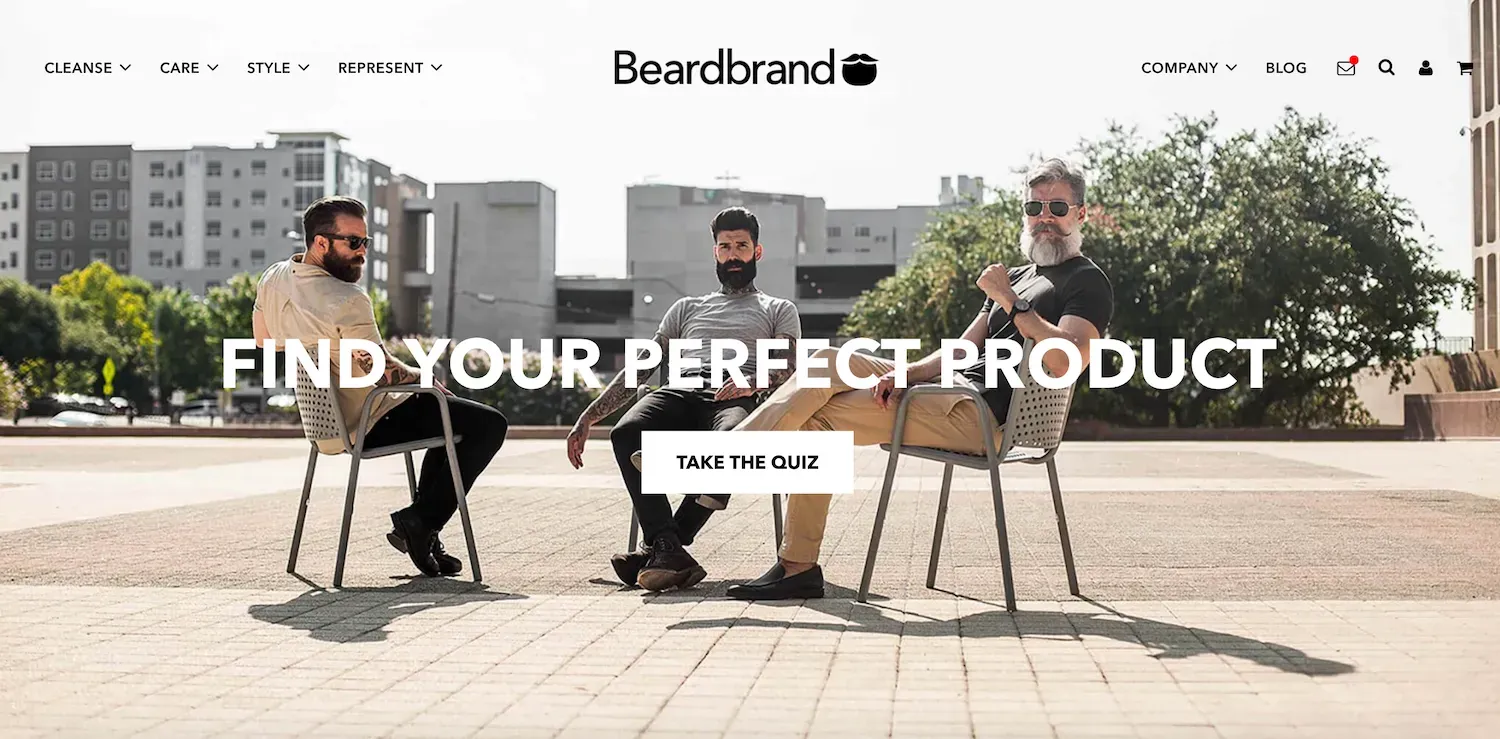
Growing the Community into an eCommerce Store With $20,000 in Sales Every Day
The founder of Bearbrand Eric Bandholz has an incredible beard.
Thus, his story deserves to be listed as one of the eCommerce entrepreneur success stories.
His passion for grooming has taken him and his company to an unbelievable level since the business was founded. At the very beginning Bearbrand was only a YouTube channel and blog.
Eric was creating content related with beard and the care of it. He had the chance to dive better into the market and he quickly realised that the grooming industry has a need for new products. The needs of the members of his community were unmet.
As every eCommerce entrepreneur would do, Eric entered the market and his goal was to fill this gap. The first products were released during 2013 and the breaking point for his brand was the feature of his blog in the NYT.
We’ll help you write your own eCommerce success story. Get automated related products and upsells to grow your webstore. Install Perzonalization for Shopify now and start your 14 day free trial.
Eric Bandholz said that the community was moving normally when a NYT reporter contacted him. The reporter was doing a story on beard care products and she was impressed with his community that was steadily growing.
As this feature was coming up, Beardbrand team worked very hard and they managed to launch the Beardbrand online store just one day before their blog was published on NYT. By this, they managed to acquire their first customers.
During the upcoming years, they established a laser focus on their community, their vision, and their messaging. These are the points from which his eCommerce success came from.
As you can see in the image below, their mission “To Foster Confidence Through Grooming” is always at the front of their homepage:
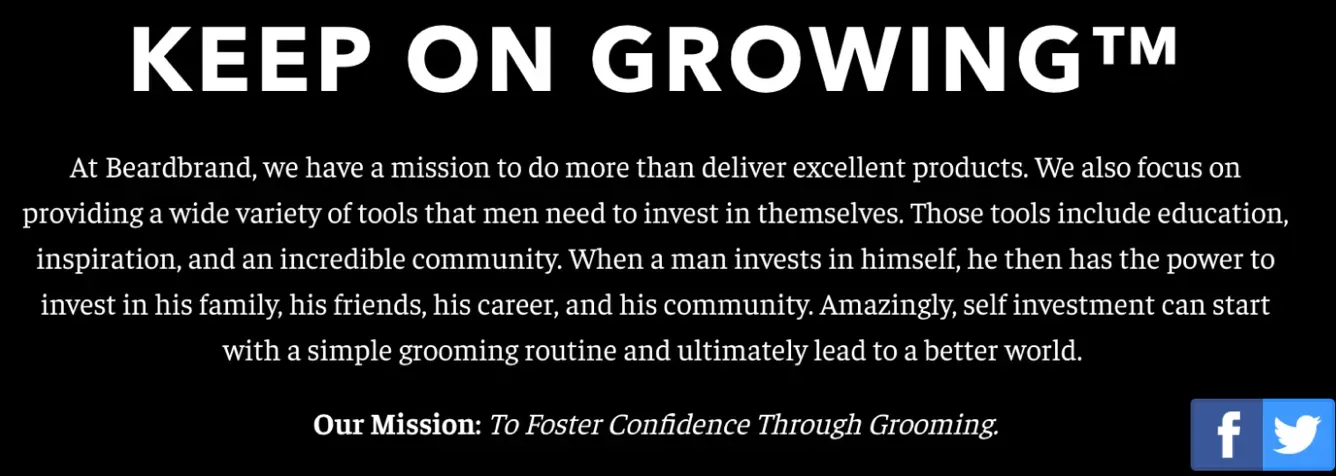
As you navigate through their eCommerce store, you can feel that Bearbrand wants men to be proud of their beards. Or “beardsmen” like Eric calls them. The store is dedicated to help these “beardsmen” understand more about their beards and learn how to create the best version of themselves. Luckily, this approach seems to have resonated well among the store’s target audience helping the company create one of the most inspiring Shopify ecommerce success stories.
The important point here is that Bearbrand does not exist only to sell grooming products online. Their first and most valuable reason for existence is to help men feel more confident and this is something that is aligned with their mission; “To Foster Confidence Through Grooming”. Obviously, Beardbrand is sending a message to its target audience that men need the company’s products to boost their confidence. For sure, all of these activities make Beardbrand one of the greatest success stories in eCommerce business.
If you want to run a successful eCommerce business, just think about the reason why your business exists in the first place. Tweet This!
The key takeaway of this story is that; if you want your story to be one of the best eCommerce success stories, think about the reason why your business exists in the first place.
Answering this “why” and having a real mission, will help you connect better with your customers.
As a result, you will build up true and long-lasting relationships. Not to mention the eCommerce success story you’re going to write.
Best eCommerce Success Stories 2) Tree Hut
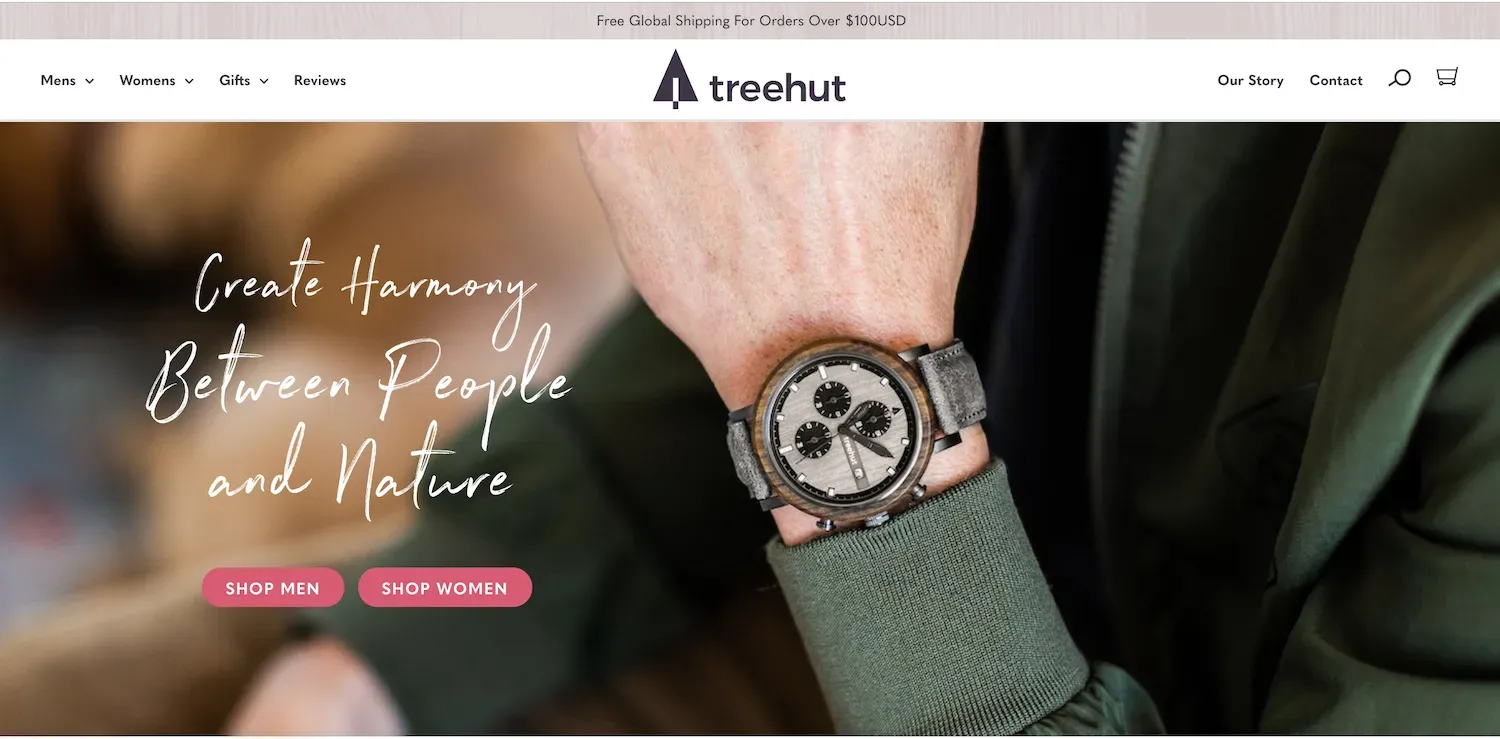
From an Etsy Marketplace Seller to an eCommerce Giant with More than $20million in Sales
Everything has changed since Tree Hut started selling on Etsy in 2014. Nowadays, Tree Hut sells directly through treehut.co and they have generated more than $20million in sales. Morover, the company employs more than 20 people and has a 8,000square foot head office in San Francisco. They manufacture their products in this facility, too.
Tree Hut’s growth path
Just two months after started selling on Etsy, Tree hut opened its own store using the Shopify platform. As Tree Hut has not raised any venture capital, this was a very little investment. This for sure makes Tree Hut one of the best eCommerce success stories on Shopify.
Tree Hut is continuously making some changes to its website. Firstly, they are regularly testing different features on their site. These could be changing the colour of the button or the font size. Secondly, the team at Tree Hut is testing some business practices like the email times, at which price to offer free shipping and how all of the changes impact their checkout rates.
The CEO of Tree Hut Julia Olson, says that testing or talking to the customers is the only way to understand their needs. She also underlines that being original is very important if you want to achieve eCommerce success.
Tree Hut does not have a super polished social media account. But people enjoy their style. Instead of the social media management, they decided to focus more on getting a product in front of the eyes of their customers and improving it every single day.
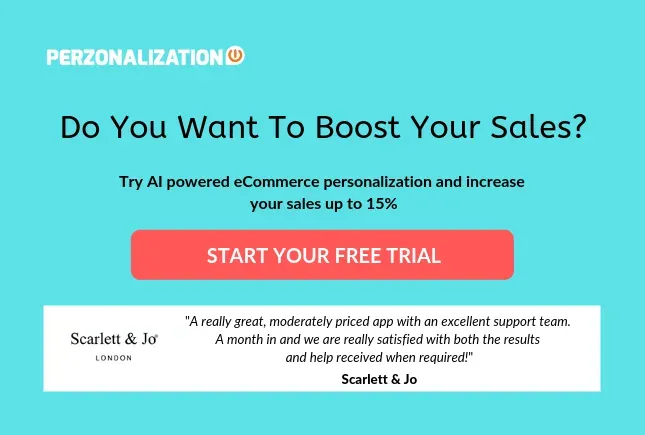
Day by day, Tree Hut’s sales have started growing rapidly. They are doing everything in house and they have to overcome every challenge of the operational part. As you can imagine, they have an operation-heavy business.
Each of Tree Hut’s watches is handmade. Therefore, it takes a long time, approximately four to six months to train someone to make watches that will match the quality of Tree Hut. Not everyone makes it to be a watchmaker but they try to find different positions for everyone.
Olson says that they have to hire watchmakers. But before hiring they need to understand if they have the suitable mentality and the right skills to be watchmakers. If everything is okay, they start to train them.
Another challenge is finding the right place for their business. It’s not a surprise to hear that Olson had always dreamed of having both an online and a brick and mortar store. For this, Tree Hut’s team found a place and moved in 2015 but the store was never opened. Being unhappy with the full production in that specific location, they moved to their new headquarters, into her own home.
This was a very rough time for Olson as she was worried about hosting business meeting in her house. She had a fear of about the credibility of her business.
Finally, after their busy holiday season in 2017, they moved to their current headquarters in San Francisco.
Olson, is still dreaming of opening an experimental physical store for Tree Hut in which customers will have the chance to customize their own watches.
Today they generate more than $20million revenues from their online sales, and they only focus on growth, which makes Tree Hut one of the best eCommerce success stories.
We’ll help you write your own eCommerce success story. Get automated related products and upsells to grow your webstore. Install Perzonalization for Shopify now and start your 14 day free trial.
Olson says that she thought quitting many times. However, this is true for most of the eCommerce entrepreneur success stories. Most people think of quitting before they eventually succeed.
But remember: Work hard, the best is yet to come 🙂
Best eCommerce Success Stories 3) Beer Cartel
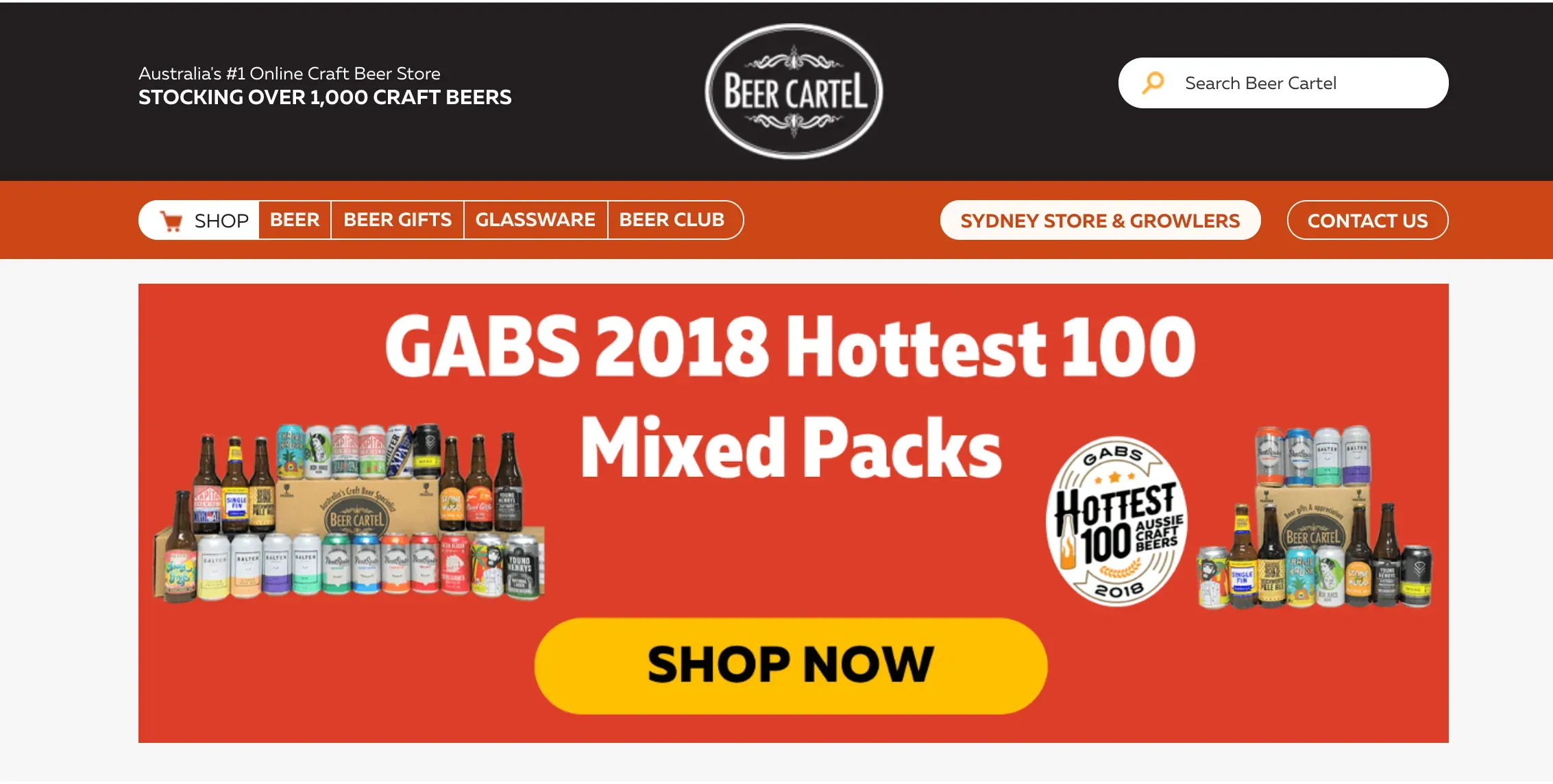
Content Marketing to Boost Sales by $65,000
Beer Cartel was founded in 2009 and has a wide range, approximately 1K, craft beers in Australia.
As the years passed by, the founder of the company, Richard Kelsey, wanted to take his business into a next level. He met up with his team and challenged them to strive for content marketing.
Did he know that he was going to be listed as one the top eCommerce startup success stories?
For sure, not!
He only wanted to increases the sales, boost company’s mailing list and create an online presence of the company.
They have developed a unique method by asking people what they do and don’t like. They did this with the help of surveys.
You can imagine that getting people to take the surveys was not easy, so they cooperated with other brands.
They had started offering tokens to the participants of the surveys and this helped them to get actual answers.
As a result, after gathering the right data, their perfect products started to come out.
So, they reached almost $65K in sales, which makes it one of the top eCommerce store success stories.
The main outcome from the eCommerce entrepreneur success story of Beer Cartel, which is one of the best eCommerce success stories, is that to be successful in the eCommerce world you should always come up with your own unique methods.
But do not forget that you need to add value to your customers with this very unique idea.
Beer Cartel succeeded with content marketing, and they have seen incredible results.
Use your own unique way and reach the results you could not imagine. Who knows, maybe yours will be one the most told eCommerce entrepreneur success stories.
Best eCommerce Success Stories 4) Dollar Shave Club

The Story of Viral Growth
Probably, you have not heard the name of Michael Dubin before, but for sure you have seen his viral video of eCommerce success.
If not, find it here.
Dollar Shave Club was founded by Michael Dubin, to make it clear that shaving and shaving products are not supposed to be complicated.
The idea is simple: Subscribe for $1 and start receiving high quality razors monthly. After some time, they made up a repricing to $5 but they added extra products like shaving butters and body cleansers.
There is no doubt that $1 and $5 are great values to answer your shaving needs.
But this is not the reason for the success of the company.
The popularity of his brand exploded just after the release of his video in which he explained the service of his company.
The main takeaway from this case which is one of the top online eCommerce success stories is that you need to create a unique identity and distinguish your brand from the competition. This for sure will be extremely difficult but it’s not impossible.
Watch the video again. The video is humorous and there were no similar company videos before. Also, his business model was unique, as no one sells razor just for one dollar.
We have to mention that Unilever acquired Dollar Shave Club for $1 billion.
We’ll help you write your own eCommerce success story. Get automated related products and upsells to grow your webstore. Install Perzonalization for Shopify now and start your 14 day free trial.
Yes it’s true. $1 BILLION. A real eCommerce success!
Now Michael Dubin is the CEO of the company.
Distinguishing from the rest will for sure make your story one of the best eCommerce success stories.
Best eCommerce Success Stories 5) Spanx
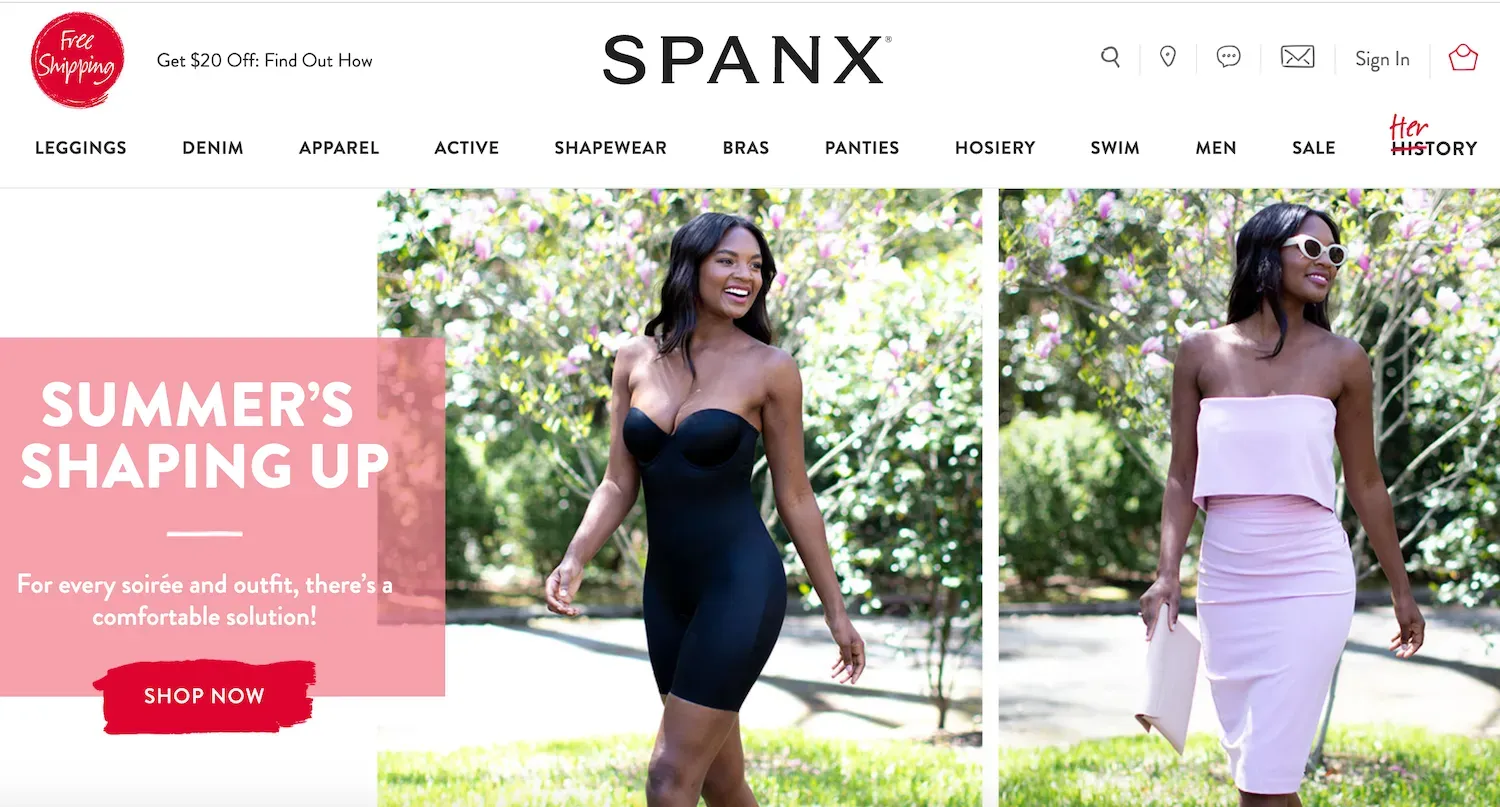
The Story of Sara Blakely
Sara started her career by selling fax machines door to door. She didn’t have any experience in business yet she created one of the best fashion eCommerce success stories.
The idea was born in the moment when she realised that she didn’t have something to wear underneath her clothing that would not create lines.
That is why she always jokes that the inspiration comes from her butt.
At the very beginning she took all her savings, around $5000 and decided to start Spanx. She couldn’t afford any lawyer to write up a patent so that is why she bought a book and learned how to write it just by herself. After that she was in the search for the right manufacturer. She was rejected by many companies but in the end, the right one was found.
Today Spanx is a great eCommerce success with a strong online and physical experience. Sara managed to grow her net worth up to $1 billion, which made her the youngest self-made billionaire in the USA.
We can easily say that Spanx is one of the best retail eCommerce success stories.
The main takeaway from the story of Sara is that, if you want your store to be listed among the best eCommerce success stories, you need to be resourceful. You should know how to avoid obstacles on your way in order to achieve your goals and write an eCommerce success story.
Best eCommerce Success Stories 6) Liberty Jane Clothing
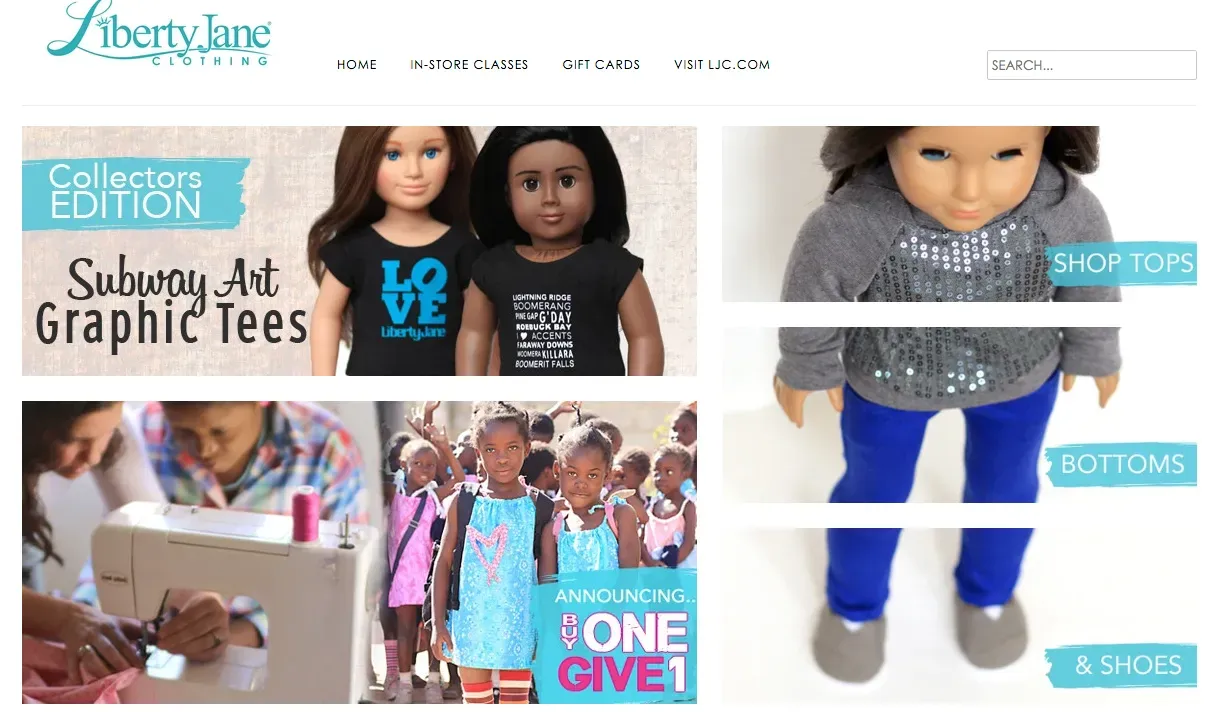
The story of how selling doll clothing online turned out to be a lucrative business idea
The co-founder of Liberty Jane Clothing is called “The Vera Wang of the 18 inch crowd” and she surely deserves this title! Having written many books and given online sewing lessons, she is one of the woman entrepreneurs who is trying to give inspiration to moms and girls.
With her husband Jason Miles, she established an online brand presence which turned out to be a great eCommerce business. Started in January 2008 as an Ebay store with the vision of creating custom fitted fashions for American Girl Doll owners, Libery Jane Clothing is now a well-known brand in a perfect niche.
Whereas Liberty Jane online store offers couture doll clothing, the pattern shop Pixie Fare hosts several sewing patterns for dolls.
The main takeaway from Cinnamon’s story is that; if you do anything with passion, it can also turn out to be an eCommerce success. People will buy in your story, get inspired and follow your steps.
Best eCommerce Success Stories: The Final Words
We have summed up some of the best eCommerce success stories, which we believe will give an idea to every entrepreneur who wants to start his own business. Now it is time for you to create your own eCommerce success story 🙂
1. Amazon

Let’s start right off with a huge Ecommerce success story from a business everyone knows. When Ecommerce is mentioned, Amazon is usually the first website that comes to mind—meaning they obviously did something right.
Originally founded in 1994 as an online bookstore, Amazon started with a much smaller focus before becoming the epic seller of everything it is today. The website got into the Ecommerce market early on, and grew by slowly increasing its product-base little by little.
But one thing that really makes Amazon stand out as an Ecommerce success story, is its pioneering of online affiliate marketing model that countless modern retailers still follow. It’s not hard to see why, as their affiliate marketing method comes with two major benefits:
1. It lets other sellers advertise and trade products on their website, grossing Amazon a share of those earned profits.
2. It naturally increases the number of customers who engage with Amazon’s website, giving their own products and services more exposure.
The Take Away
If your website draws traffic, and there are products relevant to your content, then consider implementing an affiliate marketing program.
By simply offering recommendations for products and services you signed up with from your website, you may find yourself generating a notable stream of passive income.
2. Pixie Faire

Other than titans like Amazon, you have smaller Ecommerce success stories that are just as impressive in their own right. Take Pixie Faire, for example. This business digitally sells doll clothing designs online, and was started at home by a couple of full-time parents.
They began by sewing and selling physical articles of dolls clothing for order through an eBay store. But before long, the demand for their products became too great to meet without outsourcing manufacturing, which they wanted to avoid.
The solution? Make their patterns digital. The result? Their business exploded, and their website now commands the attention of an entire niche market for custom dolls clothing. You can read an interview on how they got going here.
In the interview, some of the biggest tactics that Pixie Faire attributes its growth to are email campaigns, video advertisements, and moving their store to an Ecommerce friendly content management system. But ultimately, they believe a clear product strategy focused at an unfilled market was the biggest factor to their success.
The Take Away
Planning a carefully targeted product strategy can be all the difference in a futile business attempt, and a golden opportunity. But even if you have a dynamite product on your hands, you’ll need an effective website to market it strongly.
Magento users don’t need to worry about whether they chose the right CMS to start their own Ecommerce success story. As one of the most popular, and most effective, Ecommerce platforms on the market they can rest assured.
But to ensure a website has what it takes to best sell its products, extensions and regular maintenance are required. Services are available (like the one mentioned above) to improve your store with handy extensions, performance monitoring, and scheduled support.
3. Finch Goods

Finch Goods, a online men’s accessory store, is another fantastic example of thriving on a typical Ecommerce marketing model. This startup company quickly exploded into popularity through quality products and traditional marketing aimed largely at return business.
But there’s another reason this Ecommerce success story online is one of the better examples to study. 6-months after launch, Finch Goods founder Richard Lazazzera released a detailed blog post that explained how he did it using foundational Ecommerce elements.
As Lazazzera explains, one of the greatest hurdles he had to overcome was keeping a good stream of customer traffic flowing through his website (which is an issue familiar to any webstore owner). However, he overcame this problem by constructing a careful marketing plan that kept his store fresh in customer’s minds.
He applied abandoned cart email reminders, retargeting ad campaigns, customer loyalty programs, newsletter emails, product referrals, and other similar tactics in a focused effort to increase the relevancy of his brand to his existing customers. Basic Ecommerce marketing, but when applied in a targeted fashion as Finch Goods demonstrated, the results can be incredible.
The Take Away
Upholding strong relationships with your customers is incredibly important for any business with a range of products to sell. To inspire return customers, there are many essential tools out there available to help you get them coming back.
1. Asphalte (€25 million/year)
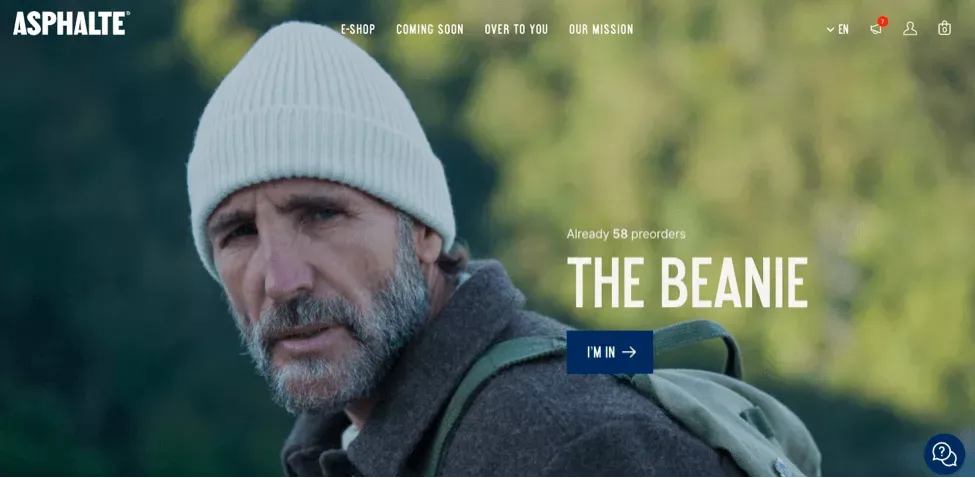
Brand Story
When Asphalte was founded in 2016, the brand chose an unusual business model: pre-order. Asphalte’s team decided to make clothes solely based on the preferences of customers, without charging them upfront.
Recipe for Success 🏆
Excellent product quality and a customer-centric culture centered around the pre-order model.
The brand’s products are long-lasting, which improves customer satisfaction and reduces environmental impact. To ensure the highest quality, Asphalte collaborates with the best manufacturers and cuts out the middlemen.
Also, Asphalte relies on customer feedback to create products. So, people become collaborators and contribute to creating high-quality clothing they actually want to buy. Website surveys ensure that the flow of feedback stays consistent.
Takeaway
Use customer feedback to create or change your products or services. Asphalte’s founders focused on getting people products they wanted instead of chasing the highest margins.
As for the Shopify contribution, it allowed Asphalte to create a good-looking website with a visitor survey section powered by Typeform. To drive visitors to the surveys, the brand uses gorgeous popup designs on the homepage and product pages.
Related:
Apparel marketing guide (includes examples from Shopify success stories like Elder Statesman,and Taylor Stitch)
2. Partake Foods (less than $5 Million/year)

Brand Story
Denise Woodard had a hard time finding healthy snacks for her daughter who was diagnosed with severe food allergies. Frustrated by the lack of options, she decided to start her own packaged goods company, but was rejected by 86 investors (!)
After finally securing the investment and building a Shopify store, Woodard saw her business take off. Her website has a range of delicious snacks, which she made herself along with a product developer. The performance: $4M+ in revenues (10-fold revenue increase in 2020 alone).
Recipe for Success 🏆
Woodard advises focusing on two things: 1) building a quality product and 2) creating and nurturing an email list.
After Woodard created a range of allergen-free cookies, she focused on marketing her Shopify store online with Google ads, social media ads, and email.
In a recent interview with Shopify, Woodard mentioned that she underestimated email as a channel for business growth. Building and nurturing an email list is key to continuous growth, said Woodard, as it helped educate customers and to keep in touch with them.
Takeaway
Have a plan to build and nurture your email list. Online advertising is good for product and brand awareness, but onsite email capture tools are a must to collect emails from website visitors. Email popups are excellent tools, especially when they contain discounts.
Partake Foods uses website popups, too. To encourage visitors to subscribe, the brand offers 15% off plus useful content. Here’s one campaign they ran.
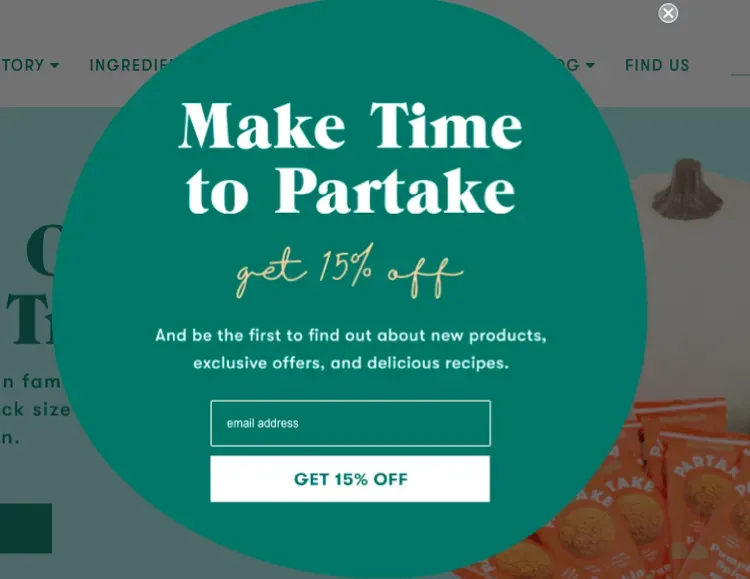
Guides for using popups to generate leads:
3. Chubbies ($45 million/year)
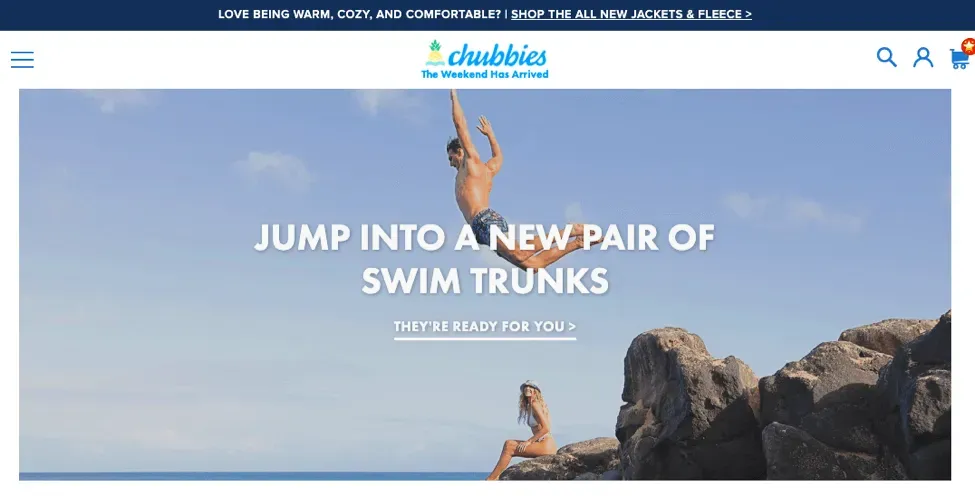
Brand Story
Chubbies is a premium apparel brand founded with a simple goal: spread the love for men’s retro shorts. The founders of Chubbies associate them with the traditional lazy weekends of their youth, which inspired them to “sell this lifestyle.”
Before starting a Shopify store, Chubbies created a brand communication strategy focused on a fun, laid-back and informal style. The strategy struck a chord with target customers, as Chubbies collected 1.5 million emails, 1.6+ million Facebook likes, and a 50% YoY growth.
Recipe for Success 🏆
Active social media marketing, constant engagement with fans, and an awesome brand voice make Chubbies a Shopify success story.
The brand uses quirky social media campaigns that also promote user-generated content. Their campaigns target male college students who like a laid back lifestyle, and actively engage with their posts.
The positive, playful, and youthful brand image is also brilliantly reflected through the website. Eventually, the brand started calling their followers Chubsters and Chubster Nation, which promotes a fun sense of community.

We wanted to sell our lifestyle to people. When we decided to start this business, we wanted to sell the notion of fun and embody that in every pair of shorts we sold.”
Tom Montgomery, Co-founder, Chubbies
Takeaway
Build communities around your brand with creative social media marketing. Chubbies created campaigns featuring pop culture references, influencers, and contests, and were able to get 1.6M Facebook followers, 576K Instagram followers, and 94K Twitter followers.
Combined with excellent customer service, Chubbies has created a truly loyal following and sense of community. This strategy is crucial, as loyal customers are likely to recommend brands to others (68%) and spend more (57%).
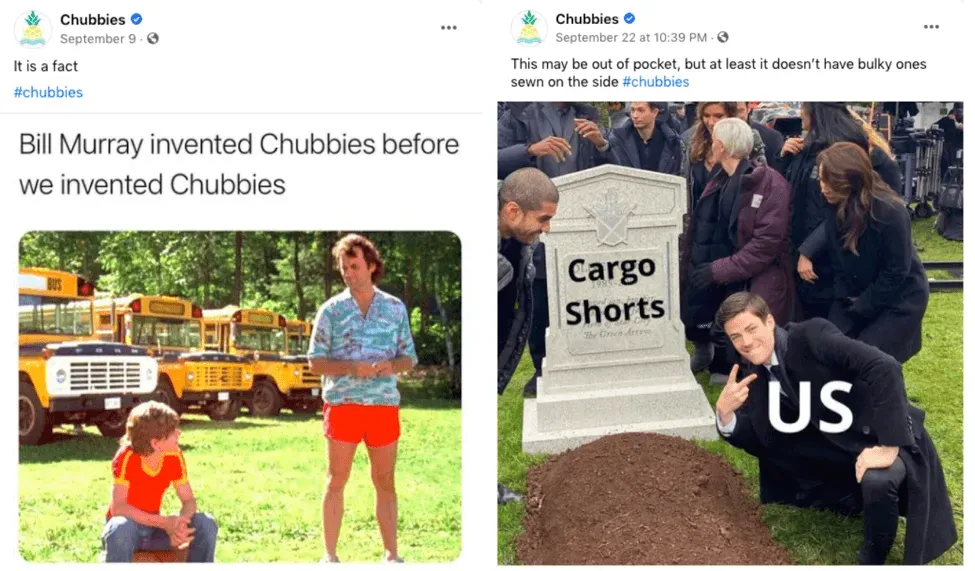
4. Holo Taco (less than $5 Million/year)
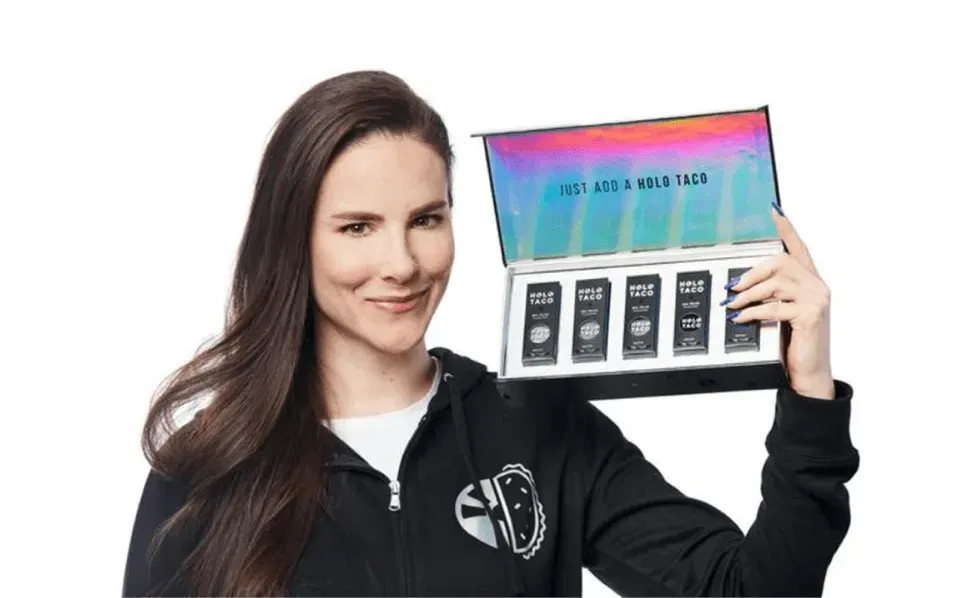
Brand Story
Holo Taco is a two-year-old nail polish brand. Started by a YouTuber Cristine Rotenberg (aka Simply Nailogical), it was inspired by her love for holographic nail polish. That’s why most Holo Taco products are colorful holographic polishes.
Rotenberg used her YouTube channel to spread brand awareness, so the launch was an anticipated event. She sold out the first collection (and many subsequent ones) within an hour, scoring high reviews for each product.
Recipe for Success 🏆
Commitment to brand values and strong brand identity.
Being a known YouTuber, Rotenberg was offered partnerships by big nail polish companies, which, according to her, prioritized profits over quality. So, she refused and took her time developing Holo Taco and launching the store.
The results were vegan, cruelty-free, produced in the US, and affordable (priced at $13) products – just what Rotenberg promised her followers. They in turn appreciated the strong commitment and responded with unbelievable social media engagement.
Shopify’s role in this success story is also prominent. The platform allowed Rotenberg to realize her vision of a vibrant, sleek, playful and colorful online store (see the screenshot below).
Takeaway
Focus on quality instead of quantity. Although Rotenberg could have had the financial backing of large companies, she turned them down because it would have interfered with her brand vision and values.
Staying true to what she promised her YouTube followers was the right choice. Now, despite being so young, Holo Taco is already a big ecommerce success story.
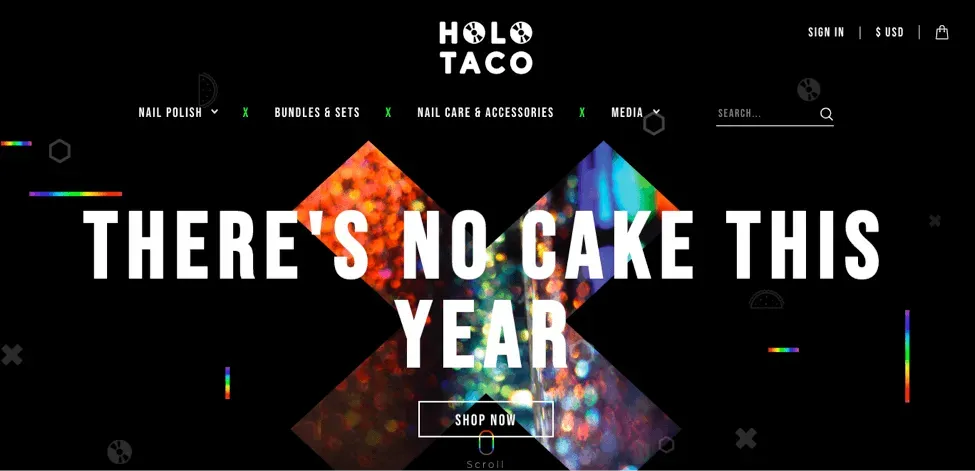
5. Maison Balzac (less than $5 Million/year)

Brand Story
Maison Balzac started out with five scented candles. The small range didn’t bother Elise Pioch, who wanted to explore product designs after working in fashion for 12 years. Run as a one-woman operation, the brand gradually expanded to homeware products, which are made in collaboration with craftspeople.
Now, Maison Balzac is a team of five. Pioch stays true to her original vision: products are created together with creatives from all over the world. The company continues its steady growth in the luxury homeware niche, selling candles, perfumes, and furniture.
Recipe for Success 🏆
Do something you love. Pioch left her job to explore product design, which was something she truly loved. This interest allowed her to be extremely personal with her products and always get inspiration for work.
Pioch approaches business growth the same way. In The Grace Tales interview, she said she follows her instinct and demand from customers. Taking big jumps or investments isn’t her priority, because it would impact her human, genuine approach to growth.
Takeaway
Be personal with your customers. Pioch says that being personal with her products, website, and social media helped her attract like-minded people. Those individuals were truly interested in her brand, so they supported her business.

“Our consumer list grows organically and by no means are we trying to attract more than what we can cope with... It’s best to be prudent and steady.”
Elise Pioch, founder, Maison Balzac
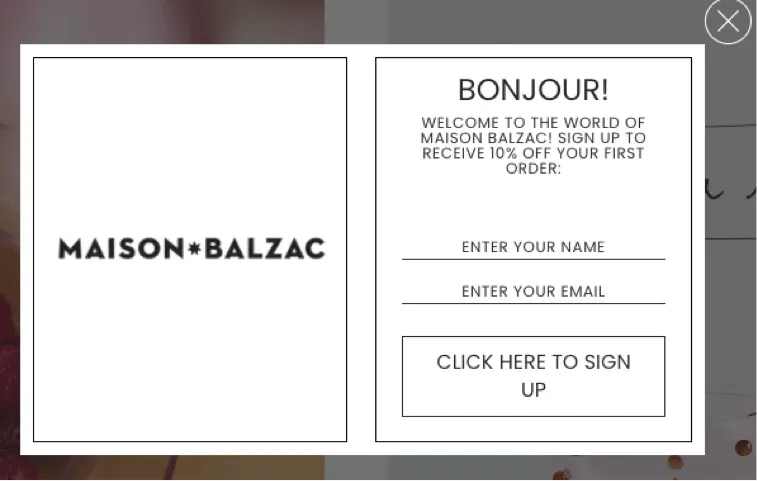
Maison Balzac is growing the email list with Wisepops popups:
👉 Try popups for Shopify
👉 Strategies to build an email list
👉 How to create unique Shopify discount codes
6. Allbirds ($305 million/year)
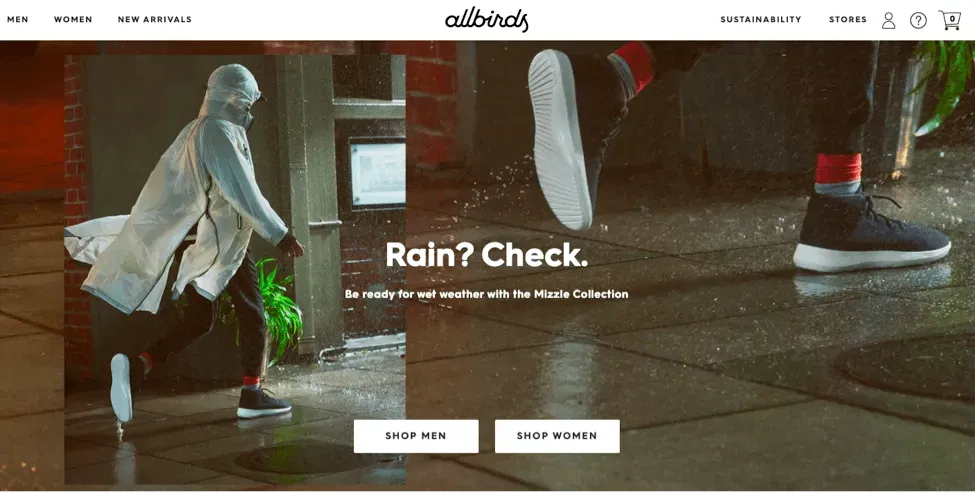
Brand Story
Allbirds began with one purpose: create a running shoe that’s both comfortable and has a small carbon footprint. To achieve this goal, the company uses planet-friendly materials such as eucalyptus tree fibers and merino wool.
Now, Allbirds is a $1.4 billion sneaker company while only selling about half a dozen of products. Despite the limited range, the brand’s products are super popular, especially among environmentally conscious customers.
Recipe for Success 🏆
Strong brand differentiation and direct-to-consumer business model.
The founders of Allbirds studied the market and understood how to differentiate their new brand. From the very early days as a crowdfunded project, the startup prioritized sustainability as the main difference from the rest of the market players.
The direct-to-consumer model allowed the business to control manufacturing and reduce prices by avoiding middlemen. Also, it enabled Allbirds to move faster and have a closer relationship with customers.
Takeaway
Allbirds used sustainability to differentiate itself in a highly competitive and crowded market. This strategy helped the brand to appeal to an emerging group of customers who were environmentally conscious.
Indeed, sustainability has reached a tipping point: 80% of shoppers value environmental responsibility and sustainability. Over 70% also claim to be willing to pay extra for environmentally responsible brands.
Faguo, another environmentally-conscious brand, plants a tree for every item sold.
Faguo business and growth strategy: Faguo Case Study
7. Madsen Cycles ($5 million/year)
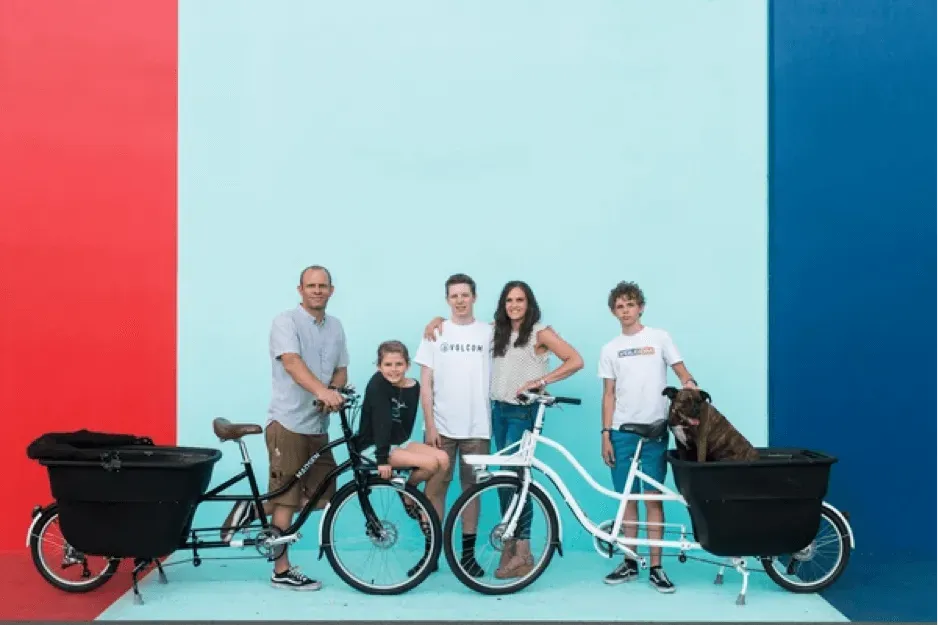
Brand Story
After visiting relatives in Denmark, Jared Madsen was impressed by the country’s bike culture. He decided to design a bike to make cycling more accessible for families in the US, too. That’s how the “Bucket Bike” was born in 2008.
Fast forward to 2021, Madsen Cycles is a top US cargo bike manufacturer with a Shopify store. Thousands of families now enjoy delightful experiences with Bucket Bikes, thanks to their practical design.
Recipe for Success 🏆
Having a unique product, the brand prioritized social media marketing as a way to grow. Besides creating quality, engaging content, Madsen Cycles also promoted customer-generated content to increase credibility.
Now, the brand uses the Instafeed app to showcase social media content on the Shopify store. Visitors can see the latest user-generated content, which creates greater trust between them and the brand.
Takeaway
Promote user-generated content in your social media marketing. Over 90% of marketers say that customers trust this content more than brand-generated content.
Madsen Cycle’s social media profiles are an excellent example of this strategy. More than one-third of content published on the brand’s Instagram page is user-generated. Here’s one as an example—look at those comments! 👇
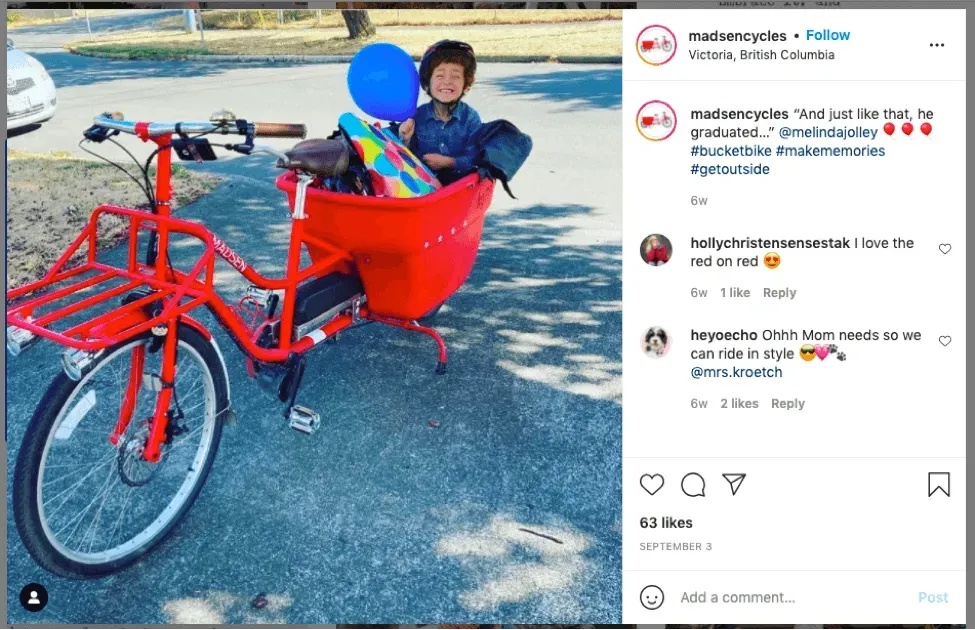
More content from our blog:
8. Beardbrand ($7 million/year)
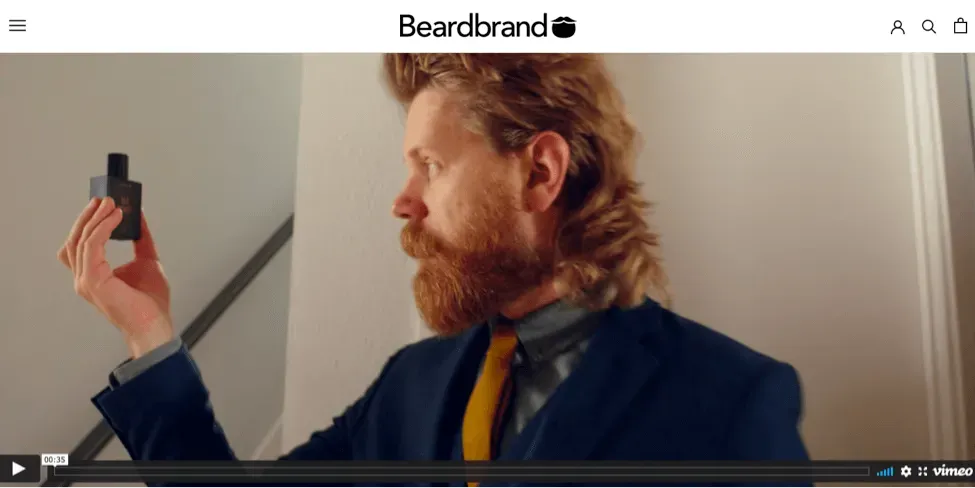
Brand Story
What to do when your employer prohibits you from growing a beard? Well, Eric Bandholz decided to quit. After giving up his job as a financial advisor, he started creating articles and videos about beard care, with a plan to start a business.
After visiting beard and mustache championships, Bandholz realized there was an underserved group of customers who didn’t have any care products available. Fast forward to today, Beardbrand is a Shopify success story with $7M annual revenue.
Recipe for Success 🏆
Bandholz saw an opportunity for business after spending time engaging with the target audience. He knew they needed proper tools to care for their beards and end the negative stereotypes about beardsmen being lazy or unkempt.
Since he had no money for large-scale production at the beginning, Bandholz started creating Shopify blogs and videos himself. Later, he even created a Beardsman Quiz to help men choose care products for their type of beard.
Takeaway
Don’t just assume something about your target customers, ask them. Bandholz did an amazing job visiting beard and mustache championships and learning more about his target group. The visits helped him discover a need for specific products that no brand fulfilled.
A genuine desire to help men take better care of their beards helped Beardbrand become a go-to source of information for the “beaded” community (direct is the main traffic source for top Shopify stores).
You can do the same: learn about your target market, survey them with quizzes, and recommend products that fit their needs. Check out Beardbrand’s blog for great content examples, too.
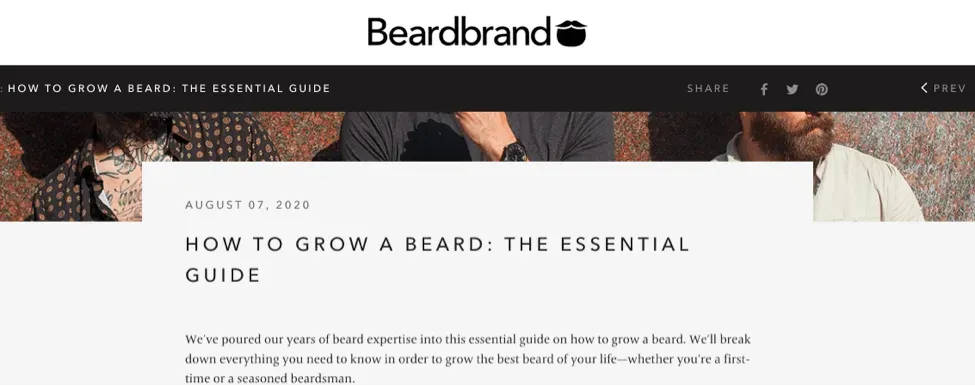
Popups can act as website surveys. They can be embedded into a website’s content or appear as non-intrusive windows:
Step-by-Step Guide to Creating Website Surveys
9. WP Standard ($5 million/year)
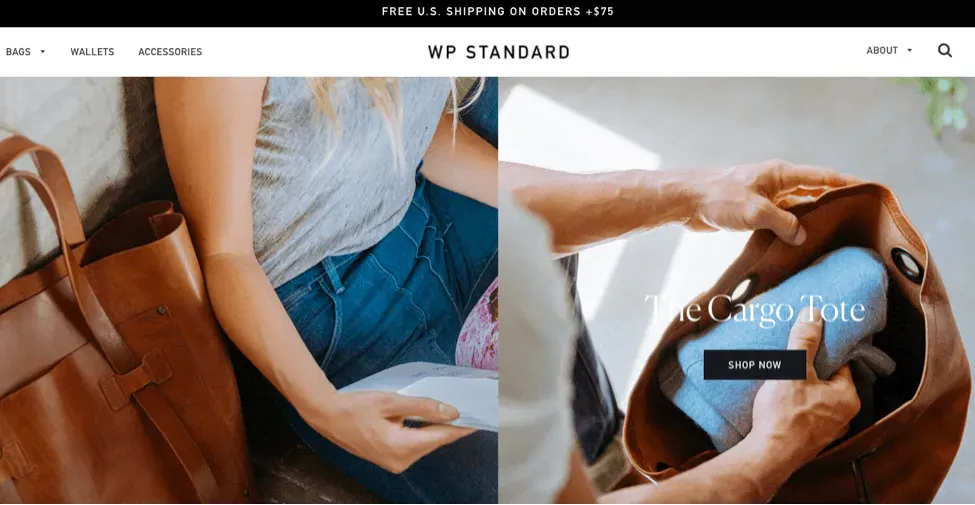
Brand Story
This Shopify success story started in 2009 when Ryan Barr founded WP Standard. Despite having just a few hundred dollars in his pocket, he wanted to sell leather guitar cases. As a guitar player himself, he knew many others would appreciate this product, too.
Fast forward to 2021, WP Standard is a seven-figure ecommerce business selling backpacks, totes, wallets, and accessories. The brand’s products are also available in popular clothing apps and retail stores.
Recipe for Success 🏆

"Email is the only channel you really own. Facebook, Instagram, and Google search are all very fickle and those companies will make you pay for access to the people on those platforms.”
Ryan Barr, Founder WP Standard
Burr’s advice for fellow business owners is to use lead generation tools to build a successful Shopify store. He himself uses Klaviyo and popups to build an email list.
Takeaway
Find a small profitable niche for your Shopify business. Burr found one because he played guitar, so tap into your hobbies and interests, too. Your unique knowledge of those hobbies might give you ideas to find a profitable niche.
Similar to other Shopify success stories, WP Standard grows because of a thriving email list. Indeed, building one as soon as possible is a must, so use email capture tools as soon as you have your store up and running.
10. Blume (less than $5 Million/year)
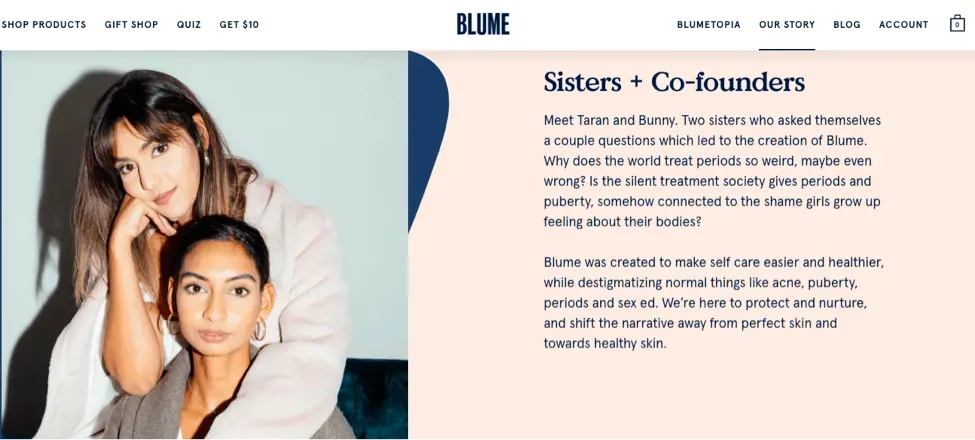
Brand Story
Blume sells skin, body, and period care products made from renewable sources. It was started in 2018 by two sisters, Taran and Bunny Ghatrora, who sought to provide girls with access to quality care and education about their bodies.
The sisters originally called their brand Ellebox, and they sold third-party products. But then they decided to rebrand and focus on specific products and reach Gen Z customers. The business model changed, too, as the founders chose to make their own products.
Recipe for Success 🏆
The brand’s founders discovered that Gen Z customers (aged 16 to 24 in 2021) wanted to switch to cruelty-free, clean, and vegan wellness and beauty products.

“There are brands like P&G, but they’re not what girls relate to. Blume is the only brand approaching the Gen Z consumers’ needs in this cohesive way across both commerce and content.”
Taran Ghatrora, co-founder, Blume
According to Taran, Blume switched to Shopify to get access to great analytics tools and increase customer engagement and lifetime value. She recommends a loyalty program, a social proof, a referral program, and a customer review app for all Shopify store owners.
Takeaway
Focus on solving the problems of your target customers. Blume began as a subscription service that served various customer groups, but then focused on Gen Z customers: they switched to vegan, eco-friendly skincare, and went on a mission to de-stigmatize female health topics.
Learn more: How Blume engages website visitors
Shopify Success Stories: Final Thoughts
Can you be successful on Shopify?
Yes.
After all, Shopify success stories are everywhere.
Besides showing that Shopify is worth it, the stories tell us another thing: There’s a lot more to becoming a successful Shopify store than just building a site.
These Shopify success stories point out several success predictors:
- Building and nurturing an email list
- Using conversion and growth tools
- Staying true to brand values and mission
- Putting customer experience above everything
- Having a strong presence on social media platforms
Let me give you a recommendation –
Try our popup builder Wisepops and take care of the first two success predictors right away. We helped many Shopify stores (including Asphalte, Blume, and Maison Balzac**)** achieve marketing and sales goals, and we’d love for you to join them.
Here’s to you becoming a Shopify success story!